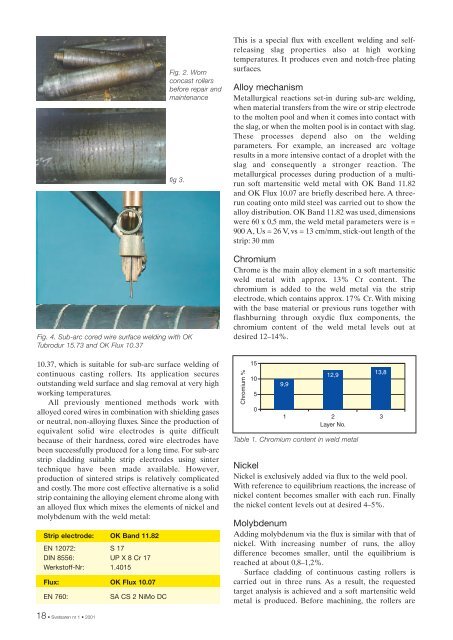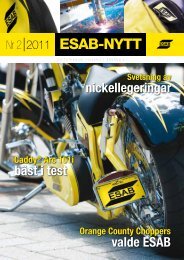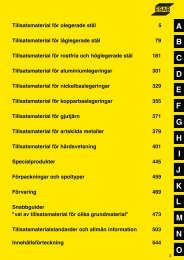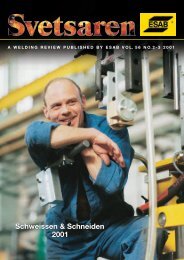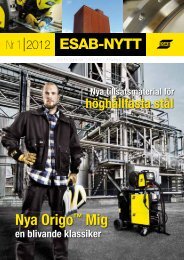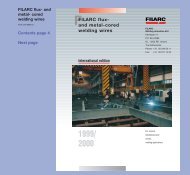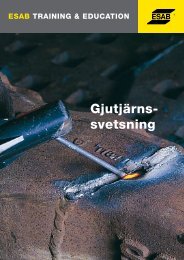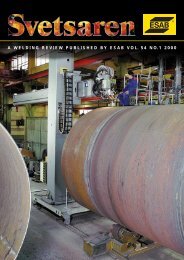Repair & Maintenance Repair & Maintenance - Esab
Repair & Maintenance Repair & Maintenance - Esab
Repair & Maintenance Repair & Maintenance - Esab
You also want an ePaper? Increase the reach of your titles
YUMPU automatically turns print PDFs into web optimized ePapers that Google loves.
10.37, which is suitable for sub-arc surface welding of<br />
continuous casting rollers. Its application secures<br />
outstanding weld surface and slag removal at very high<br />
working temperatures.<br />
All previously mentioned methods work with<br />
alloyed cored wires in combination with shielding gases<br />
or neutral, non-alloying fluxes. Since the production of<br />
equivalent solid wire electrodes is quite difficult<br />
because of their hardness, cored wire electrodes have<br />
been successfully produced for a long time. For sub-arc<br />
strip cladding suitable strip electrodes using sinter<br />
technique have been made available. However,<br />
production of sintered strips is relatively complicated<br />
and costly. The more cost effective alternative is a solid<br />
strip containing the alloying element chrome along with<br />
an alloyed flux which mixes the elements of nickel and<br />
molybdenum with the weld metal:<br />
Strip electrode: OK Band 11.82<br />
EN 12072: S 17<br />
DIN 8556: UP X 8 Cr 17<br />
Werkstoff-Nr: 1.4015<br />
Flux: OK FIux 10.07<br />
EN 760:<br />
SA CS 2 NiMo DC<br />
Fig. 2. Worn<br />
concast rollers<br />
before repair and<br />
maintenance<br />
fig 3.<br />
Fig. 4. Sub-arc cored wire surface welding with OK<br />
Tubrodur 15.73 and OK Flux 10.37<br />
This is a special flux with excellent welding and selfreleasing<br />
slag properties also at high working<br />
temperatures. It produces even and notch-free plating<br />
surfaces.<br />
Alloy mechanism<br />
Metallurgical reactions set-in during sub-arc welding,<br />
when material transfers from the wire or strip electrode<br />
to the molten pool and when it comes into contact with<br />
the slag, or when the molten pool is in contact with slag.<br />
These processes depend also on the welding<br />
parameters. For example, an increased arc voltage<br />
results in a more intensive contact of a droplet with the<br />
slag and consequently a stronger reaction. The<br />
metallurgical processes during production of a multirun<br />
soft martensitic weld metal with OK Band 11.82<br />
and OK Flux 10.07 are briefly described here. A threerun<br />
coating onto mild steel was carried out to show the<br />
alloy distribution. OK Band 11.82 was used, dimensions<br />
were 60 x 0,5 mm, the weld metal parameters were is =<br />
900 A, Us = 26 V, vs = 13 cm/mm, stick-out length of the<br />
strip: 30 mm<br />
Chromium<br />
Chrome is the main alloy element in a soft martensitic<br />
weld metal with approx. 13% Cr content. The<br />
chromium is added to the weld metal via the strip<br />
electrode, which contains approx. 17% Cr. With mixing<br />
with the base material or previous runs together with<br />
flashburning through oxydic flux components, the<br />
chromium content of the weld metal levels out at<br />
desired 12–14%.<br />
Chromium %<br />
15<br />
10<br />
5<br />
0<br />
9,9<br />
12,9<br />
13,8<br />
1 2 3<br />
Layer No.<br />
Table 1. Chromium content in weld metal<br />
Nickel<br />
Nickel is exclusively added via flux to the weld pool.<br />
With reference to equilibrium reactions, the increase of<br />
nickel content becomes smaller with each run. Finally<br />
the nickel content levels out at desired 4–5%.<br />
Molybdenum<br />
Adding molybdenum via the flux is similar with that of<br />
nickel. With increasing number of runs, the alloy<br />
difference becomes smaller, until the equilibrium is<br />
reached at about 0,8–1,2%.<br />
Surface cladding of continuous casting rollers is<br />
carried out in three runs. As a result, the requested<br />
target analysis is achieved and a soft martensitic weld<br />
metal is produced. Before machining, the rollers are<br />
18 • Svetsaren nr 1 • 2001


